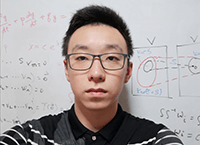Alumni

Tianyi Wang
Bio
Wang Tianyi is a rising senior at Bard Early College, China. He is interested in mathematics and its applications in physics. His previous research experience includes nonlinear oscillators and the solutions of second-order nonlinear differential equations in general vector space. He took calculus, linear algebra, and calculus-based mechanics and will take differential equation and multivariable calculus in the coming year. He will major in mathematics or physics in the future, hoping to bring his passion to a professional level.
Project: Ordinary Differential Equation and Complexity/Chaos Theory

Goal
Differential equations are used widely to model real-world situations and are becoming an important topic in chaos theory and complex system. This project focuses on ODE with specific forms such as x''(t)+x'(t)=f(x(t)). I will investigate some functions f that produce chaotic solutions and analyze the mathematical structure of these equations via visualization or machine learning (possibly). One possible result is to find the set of functions f that produce chaotic results and to be able to apply them to real-world situations, such as the pendulum equation.
Summary of Results
Differential equations are widely used in math, physics and engineering. These equations are very useful in modeling complex systems that are changing with time. For this exploration, the differential equations we are looking at have a particular form: x''[t]+x'[t]==f[x[t]], where f is a real-valued function. The solutions exhibit a variety of different behaviors, some of which are stable, others chaotic. The goal of this project is to investigate different chaotic behaviors of these equations and to be able to detect them. Throughout this project, I successfully detected the chaotic behavior of different differential equations and classified them. The output includes a function that generates the phase portrait of some differential equations and a function that tells the interval(s) in which the function is chaotic for input functions (f[x]) that are continuous. Finally, there is a machine-learned classifier function that can classify different behaviors of chaotic functions with an accuracy of about 99%–100%.
Future Work
In the future, I would like to investigate the mathematical logic behind different kinds of behaviors of these ODEs and expand my work to third-order ODEs.